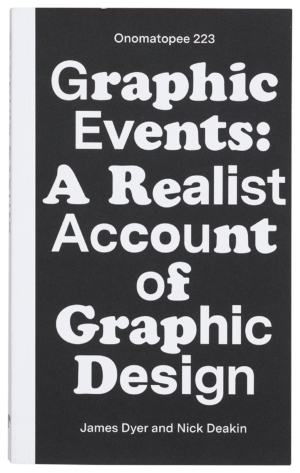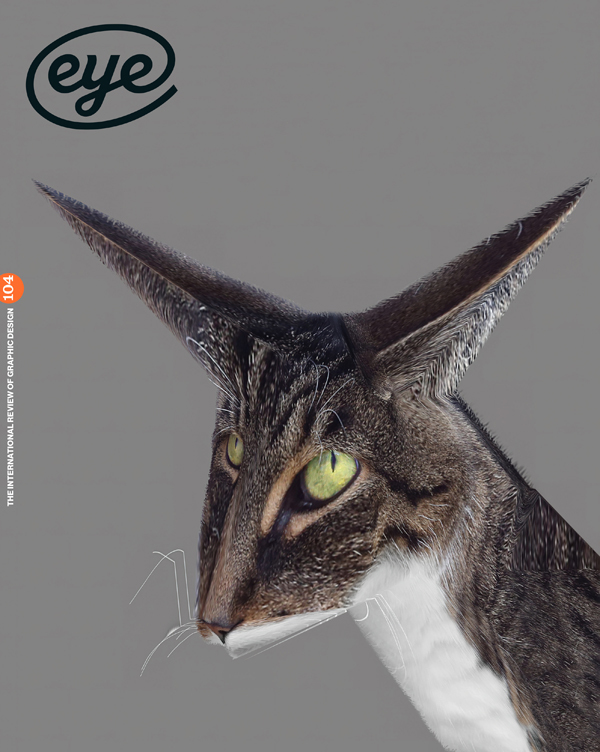Spring 2023
The purpose is what it does
Graphic Events: A Realist Account of Graphic Design
By Nick Deakin and James Dyer Designed by Totally Okay, Onomatopee, €22.00
What happens to a design after it has entered the world? What new meanings are generated from it? What unintended consequences come from its distribution? What unusual juxtapositions develop in a new context? How is it received differently, on the street by a pedestrian? What does it make us feel when it is removed from the slick, credited, studio portfolio website? These questions animate Graphic Events.
Authors and editors Nick Deakin and James Dyer, both graphic designers and educators, write in the book’s introduction that such questions are all too often left out of the design discourse, which instead favours analysis of process, concept, and the final artefact.
The ‘graphic events’ of the title is the authors’ attempt to separate the ‘graphic’ from the ‘design’: where design is about planning and intentionality, events are unplanned, spontaneous, and subversive. The design is about control; the event about agency. The graphic, then, has a life beyond that plan as it becomes part of the visual landscape and takes on a life of its own. Here, the split between the professional and the amateur, the designed and the vernacular falls away; a graphic event becoming a living thing exists in particular contexts across time. ‘To think of graphics in terms of events,’ they write, ‘is to think of them as things that endure, occur, exist.’
Structured as a series of short essays, credited to both Deakin and Dyer as well as a handful of other contributors; interviews with designers, philosophers, and critics; and visual compositions, the authors create an intellectual collage – calling to mind the idea of an event – that explores how graphic design is affected once it leaves the studio. The authors write in a casual yet informed prose invoking the feeling of the flâneur – moving seamlessly from one idea to the next – embodying the idea of the event in their texts. An essay by Teal Triggs looks at vernacular signage on her walks during the early Covid-19 lockdowns while another, by Fraser Muggeridge (see Eye 100), explores his use of incorporating chance and play into design processes. The interviews with design studios DR.ME and Textbook Studio explore the use of collage in graphic design processes as a metaphor for visual culture at large. (These interviews, interestingly, are rotated 90 degrees.)
If the book has a fault it is that Deakin and Dyer spend a lot of time telling and very little time showing. They write, again and again, about the importance of the graphic event and what they mean philosophically yet rarely point to actual events in the real world to demonstrate their value. ‘Graphic events evade design,’ they write. ‘The agency the graphic accrues through this evasion has significant potential.’ It is unclear what this potential might be. ‘The graphic event is not simply about mobilising descriptions of details in design,’ they write, vaguely, in the conclusion, ‘it is about complexifying design for the sake of not knowing, being alert, and taking difference seriously.’
Despite
this, in identifying and naming the graphic event, Deakin and Dyer
give language to a new way to talk about and evaluate design. The
operational research theorist Stafford Beer wrote that ‘the purpose
of a system is what it does.’ I found myself thinking of this quote
reading Graphic
Events because
the same could be said of graphic design. ‘We know that graphics
have at some point been designed,’ Deakin and Dyer write, ‘but
they live on beyond the intentions of those designs.’ To follow
Beer’s argument, the event is the purpose. Designers don’t fully
know how their work will function until they surrender this control
and observe its event. This, Deakin and Dyer believe, is critical to
the future of design: we should not prioritise the designer’s view
over that of the pedestrian. Here, the designer should step outside
the portfolio and on to the street.
Jarrett Fuller, designer, podcaster, professor, writer, Raleigh, US
First published in Eye no. 104 vol. 26, 2023
Eye is the world’s most beautiful and collectable graphic design journal, published for professional designers, students and anyone interested in critical, informed writing about graphic design and visual culture. It is available from all good design bookshops and online at the Eye shop, where you can buy subscriptions and single issues.

